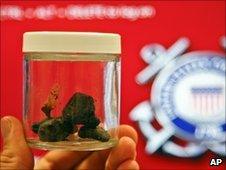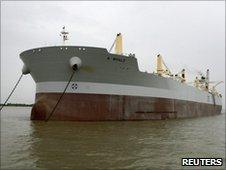Gulf oil spill reaches Texas as tar balls wash ashore
- Published

It is not clear if the tar balls drifted from the spill or were carried on a ship
Tar balls have landed on a Texas beach, meaning oil from the Gulf of Mexico spill has hit all five US Gulf states.
Tests identified the small amount of tar found on the Bolivar Peninsula, north-east of Galveston, as coming from BP's blown-out well off Louisiana.
But officials said it was unclear if it had drifted hundreds of kilometres from the leak site or had fallen from ships taking part in the clean-up operation.
Up to 60,000 barrels of oil a day have leaked into the Gulf since 22 April.
BP has said its oil-capture systems collected or burnt off 24,980 barrels of oil on Monday, according to the Reuters news agency.
Over the past week, efforts to clean up the spill have been hampered by the first hurricane of the Atlantic season, Hurricane Alex.
Separately, BP said it could cover the costs of the clean-up and compensation claims without selling new shares, amid rumours that a Middle Eastern sovereign wealth fund was about to buy a stake.
Relief wells
The commander of the US Coast Guard in the Galveston region, Capt Marcus Woodring, said about five gallons (19 litres) of tar balls from the Deepwater Horizon leak had been found on Saturday.
But he said it was impossible to confirm whether they had drifted from the site of the leak, about 550 miles (885km) away, or had dropped off one of the ships carrying collected oil to Texas to be processed.
The joint BP-US government response team said there were doubts that the oil had drifted all the way from the spill.
"The testing found that the oil was lightly weathered, raising doubts that the oil traversed the Gulf from the spill source," a statement said.
Galveston's mayor, Joe Jaworski, said he was hopeful the analysis was correct and that the tar balls were not a sign of more oil to come.
"This is good news. The water looks good. We're cautiously optimistic this is an anomaly," he said.
Texas Land Commissioner Jerry Patterson meanwhile promised in a statement that any of the state's coastline affected by the spill "will be cleaned up quickly and BP will be picking up the tab".
The coasts of four other US Gulf states - Louisiana, Alabama, Mississippi and Florida - have so far been more seriously affected by the spill.
Tar balls and oily water were spotted on Monday near the mouth of Lake Pontchartrain, a large lake to the north of New Orleans, in Louisiana.

The world's largest skimmer is one recent arrival to the Gulf
Rough weather since Hurricane Alex passed through the Gulf, to the south of the spill, has hampered clean-up operations for the last week.
Tests of a giant tanker refitted to scoop up oil have been inconclusive because of high seas, the ship's operators said.
The first of two relief wells being drilled to permanently cap the well is seven days ahead of schedule, but officials said on Tuesday that it was still likely to be mid-August before the operation could be completed.
In the meantime, some of the leaking oil is being piped to the surface from a cap over part of the well.
BP spokesman Mark Proegler has said the company hopes to connect "by the end of the week" a third tanker, Helix Producer, to its collection system to increase capacity to 53,000 barrels a day from the current limit of 28,000.
The Helix Producer will form part of a new collection system involving a so-called floating riser and four vessels which will be able to disconnect and reconnect quickly, reducing the time lost when collection is halted because of rough seas. The new system should be able to handle up to 80,000 barrels of oil a day.
The Deepwater Horizon rig - operated by Transocean on behalf of BP and its partners - exploded on 20 April and later sank with the loss of 11 lives, leading to the worst oil spill in US history.
US scientists estimate 35-60,000 barrels per day are leaking from the well, about one mile (1.6km) below the surface of the water.

Mud that is heavier than the oil will be pumped into the well to stop the flow of oil. Cement will then be pumped in to seal it.